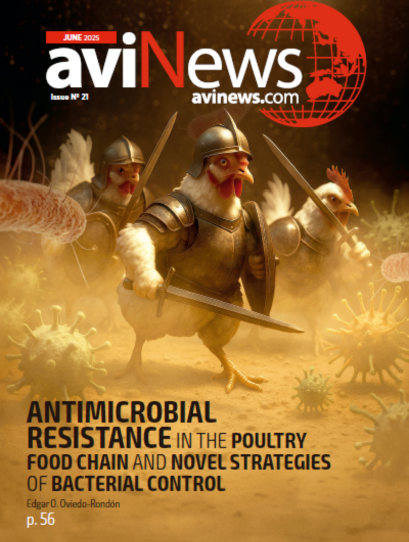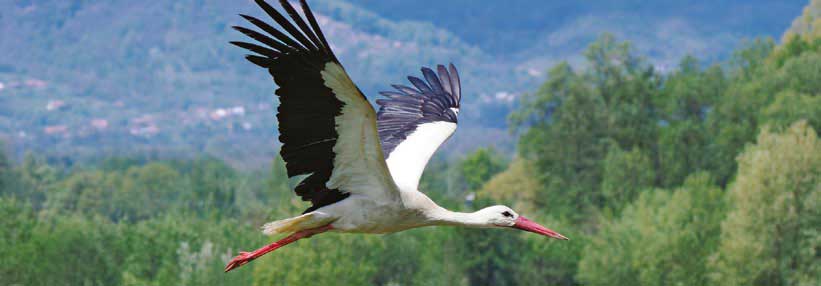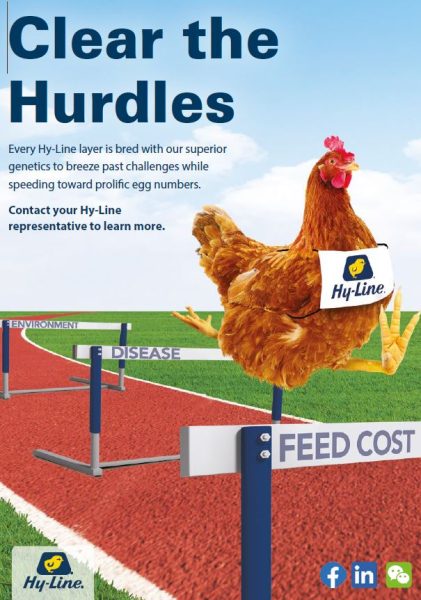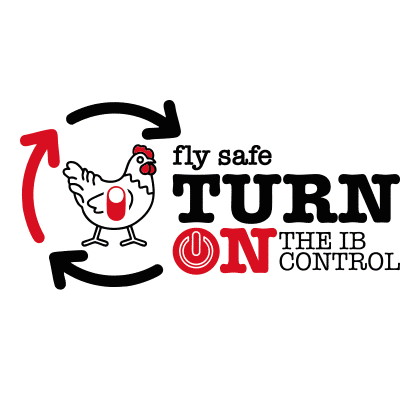Content available at: Indonesia (Indonesian) Melayu (Malay) ไทย (Thai) Tiếng Việt (Vietnamese) Philipino
Biosecurity
Previous highly pathogenic outbreaks of AI (HPAI) were thought to be the result of flock exposure to a lowly pathogenic strain of AI (LPAI) and during the infection process the virus mutated to the more detrimental HPAI strain.
The HPAI was then transferred to other farms through breaches in biosecurity appearing as clusters of farm infections in a region. This mode of infection and transmission is still valid.
- The current strain of HPAI infection appears to have adapted to wild birds.
- Surveillance of migratory bird mortalities has detected the HPAI Eurasia H5N1 in U.S. wild bird populations.
- Wild birds with HPAI symptoms have been found along the east coast from northern Canada all the way to Florida.
- Surveillance also detected H5N1 positive wild birds in areas around the Ohio, Mississippi, and Missouri Rivers.
- Likewise, sporadic, and clustered infections of back yard, hobby, and commercial poultry flocks across the Midwest have been reported.
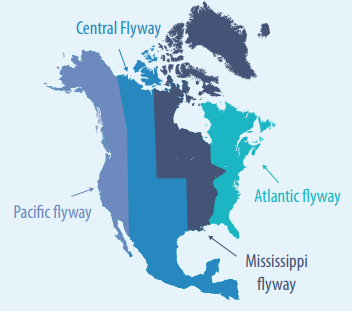
MIGRATION ROUTES
Wild bird migration routes across North America are generally shaped by geography, forming 4 flyways (Atlantic, Mississippi, Central and Pacific).
- The increasing day length with the onset of spring stimulates the migration of birds in the southern states to the far northern regions of North America.
Atlantic Flyway that extends from southwest Africa northward through Europe and includes Central Siberia, Greenland, and Canada.
This creates the opportunity for disease to migrate from one continent to another and may explain the presence of Eurasia H5N1 in wild bird populations across the US east coast in 2022.
GREATER SPREAD IN WILD BIRDS
There is concern that AI will further spread in wild bird populations. One area of significant wild bird concentration is the Artic Refuge located in northern Alaska.
It is here that 200 species of wild migratory birds from all 4 US flyways along with the East Asian-Australasian and West Pacific Flyway come together to build nesting sites.
- Long days support the growth of forage and insect populations necessary to feed offspring.
- The onset of winter drives birds south to warmer environments and forage.
The accumulation of wild birds in the Artic Refuge allows transmission of both LPAI and HPAI within and across species. It is expected that winter migration will cause an increase in AI during the fall.
CHARACTERISTICS OF A CARRIER SPECIES
When considering an effective biosecurity program, it is important to understand the species and how it moves.
- Be cautious of waterfowl and shorebirds that are susceptible to influenza viruses but may be asymptomatic carriers or birds experiencing minor symptoms. This has been observed in wild birds across the Atlantic and Mississippi flyways.
- Be aware of bird species that are abundant and widespread. The risk of infection comes from the opportunity for contact.
- Birds that are migratory or nomadic serve as viral vectors. Resident waterfowl (birds that do not migrate) can be infected by interacting with migrating waterfowl. Since resident fowl stay in a defined location, they will continue to shed virus that can then be transmitted through fecal contamination of shoes and clothing to commercial poultry and back yard flocks.
- Be aware of bird species that cluster together to form high density flocks. Clustering may be a daily or seasonal event that increases the opportunity for bird-tobird transmission within and across species. Note that there are times of the year where waterfowl will cluster during periods not associated with migration. It is not unusual for waterfowl to group together during the post-breeding, flightless molt period.
- The opportunity for direct contact with feces of infected waterfowl is greater for free ranging, mixed flocks. It is possible that an intermediate vector, such as songbirds, can become infected and transmit it to poultry by food and water sources. Since songbirds can carry H5N1, eliminate nesting sites in outdoor and commercial poultry facilities. Likewise, it is recommended that outdoor flocks be confined to indoors during periods of AI movement.
- H5N1 is often spread through droplets and therefore easily transmitted in water. Assume that water visited by waterfowl is contaminated with AI or other disease-causing agents. Never use open water (stream, river, pond, or lake) as a water source for your birds.

of avian influenza.
PROTECTING THE FARM WITH BIOSECURITY
Fortunately, AI is vulnerable to cleaners and disinfectants as well as good biosecurity practices.
- For example, H5N1 is easily killed by acidic (pH < 5.5) or alkaline (pH > 8.0) conditions and disinfectants are very effective against H5N1.
Environmental conditions associated with temperature and humidity are important for AI survival.
- The virus survives best under cool, dry conditions and longer in soil and feces than on hard surfaces.
Considering the mode of infection in a biosecurity plan can improve protection. Following the basics will help prevent exposure to AI.
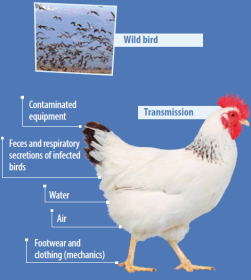
- The most important step is to limit contact with outside birds.
- The farm team must not have contactwith other birds. Possessing back-yard birds must be prohibited. All team members must sign an agreement to avoid contact with and possession of other birds.
- Respect all required out-time for bird contacts. There are many ways to indirectly encounter a higher-thannormal concentration of wild birds. This is particularly important for hunters who, are at significant risk of encountering birds. Stay away from places with an outdoor water feature. Do not visit fairs, bird swap meets or feed stores that sell day old chicks. Since AI is in wild bird populations do not attract birds with wild bird feeders.
- If a visitor plans to visit your farm, they must also follow the rules associated with outside bird contact. In addition, plan visits according to generation, age, and health condition of the flock. Be cautious of contact with other growers.
- The chances of AI transmission from wild birds are minimized by physical barriers.
- When planning farm placement, select a location with as much distance as possible from surrounding farms.
- Select an area that does not contain open water that will attract birds to your farm.
- Build a secure fence around the farm to control entry and exit points.
- Create a clear distinction between dirty and clean sides of the farm. Install signs so there is no confusion and as a reminder for team members and visitors.
- Ensure adequate vermin control.
- Keep grass and other vegetation controlled.
- Everyone and everything that passes through the farm gate must be cleaned and disinfected.
- Provide entry gate equipment capable of cleaning and disinfecting all incoming vehicles. If possible have farm dedicated vehicles that stay only on the clean side of the farm. Keep on-farm vehicles clean and disinfected on both the inside and outside.
- It is not recommended to share equipment between farms, especially when birds are present.
- If vehicles or equipment enter the farm they must be thoroughly treated. All areas of the incoming vehicle that may
have contacted bird feces must be cleaned and disinfected, including tires, wheel wells and undercarriage.- Be mindful of dirt because it can shield AI from disinfectants or interfere with the disinfectant potency.
- Do not forget to disinfect the vehicle floorboards, pedals, steering wheel, and seats.
- Ensure that everyone entering is registered by signing a visitor log. This will help trace the source if an outbreak does occur.
- Premises must have adequate and clean shower facilities for team members and visitors.
- Only essential items enter the farm. All items that are needed on the clean side of the farm must be disinfected before entry.
- Once on the clean side of the farm, it is important to remain clean.
- When entering the clean side of the farm, change into farm dedicated clothing and footwear.
- Regularly clean concrete pathways between buildings.
- Provide dedicated footwear for each house on the farm.
- Use boot dips and sanitize hands prior to entering a house.
- Clean feed spills immediately.
- Maintain all pest control measures.
- Dispose of daily mortality consistent with standard operating procedures.
- Each house should be treated separately.
- Team members should respect defined areas for changing boots before entering.
- Ensure the house and entry doors are sealed and kept closed and locked when unattended.
- Ensure each house is monitored for wild bird nests, rodent, and insect activity. All wild bird nests must be removed immediately, and nesting area disinfected.
- All supplies and equipment must be disinfected prior to house entry.
- Consider materials that must be brought onto the farm.
- Litter Material
- Keep all wood shavings, straw, or rice hulls in covered storage.
- Treat litter with organic acids or approved chemicals.
- Source litter material from approved suppliers.
- Remove spent litter from the farm and dispose in accordance with local regulations.
- Feed
- Use only clean raw materials.
- Apply heat and chemical treatments as defined by local legislation.
- Manage feed trucks, feed bins, and feed systems to remain fresh, clean and mold free.
- Water
- Adopt a weekly sanitizing/ flushing water program.
- Clean and disinfect total water system between flocks.
- Test water to maintain acceptable chemical and bacterial load.
- Only use water from a known clean source and never from open water supplies.
- Litter Material
CONCLUSION
There is a great deal of planning that must go into developing a comprehensive biosecurity plan. Unfortunately, even the best plans fail without commitment from all team members.
- Sometimes plans of biosecurity fails because they are too complicated and unreasonable.
- Sometimes the plan is too expensive to maintain.
- Often the plan fails because team members are in a hurry or impatient with the process.
For these reasons, create a program that works for the farm and team members.
PDF
